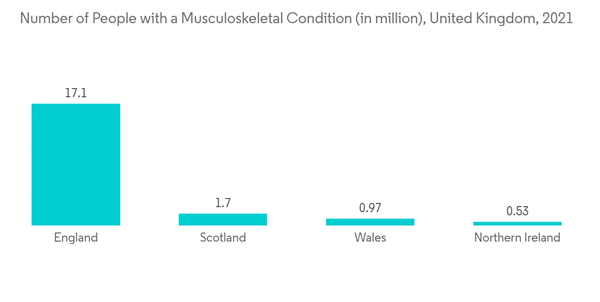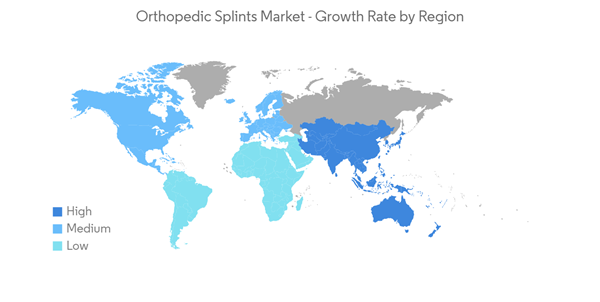COVID-19 had a temporary negative impact on the market as the sudden onset of the pandemic resulted in canceling of many surgeries. The volume of orthopedic surgeries has significantly declined during the pandemic, owing to the stringent guidelines by the regulatory authorities to avoid all non-emergent surgeries. For instance, according to the article published in Cureus Journal in August 2021, the number of orthopedic surgeries fell by 22.8% during the first year of the pandemic. This led to a decrease in the demand for the orthopedic splint. Moreover, the market is gradually stabilizing as COVID-19 cases are declining to result in the return of the normal demand levels for an orthopedic splints.
Factors such as the increasing number of musculoskeletal disorders, increasing bone fracture cases, and a rise in the geriatric population are expected to fuel the market growth over the forecast period. Physicians often suggest the use of orthopedic splints to treat muscular, or muscle-nerve diseases that cause pain. Individual differences in pain include intense pain, shocking pain, and pain that worsens with movement. Thus, the use of orthopedic splints can be beneficial in people who experience severe pain in the hip, knee, ankle, feet, and in back muscles. According to the WHO data updated in July 2022, musculoskeletal diseases (MSD) are the main cause of disability globally, that affected 1.71 billion people globally in 2021. Thus, the burden of MSD globally is expected to drive demand for orthopedic splints, contributing to the overall market growth.
Furthermore, the increase in the geriatric population is expected to be a significant contributor to the studied market. According to WHO data published in October 2021, between 2015 and 2050, the proportion of the world's population over 60 years is predicted to nearly double from 12% to 22%. In 2050, 80% of older people will be living in low- and middle-income countries. This target population is more prone to age-related MSD and fractures due to falls. Thus, it is expected to generate demand for orthopedic splints used for pain relief purposes.
Therefore, due to the factors mentioned above, the studied market is anticipated to witness growth during the forecast period. However, negligence of the target population toward minor injuries is predicted to hinder the market growth.
Orthopedic Splint Market Trends
Spinal Segment is Expected to Witness Growth Over the Forecast Period
A spinal splint is a rigid or flexible device that maintains in position a displaced or movable part. An increase in the number of patients suffering from spinal cord injury (SCI) is likely to be the key factor contributing to the growth of the segment. According to the National Library of Medicine data updated for spinal cord injuries in August 2021, motor vehicle collisions account for 38% of new SCI each year, 30% of SCI are due to falls, 13% are due to violence, 9% from sports injuries, and 5% from medical and surgical etiologies in the United States. Additionally, as per the source mentioned above, there are approximately 17,000 new cases of SCI each year, and roughly 282,000 people are estimated to be living with SCI in the United States. Hence, the high burden of SCI in countries across the globe is anticipated to drive the demand for the use and availability of orthopedic splints. Therefore, it is poised to drive segment growth.Moreover, the use of splinting is increasing for patients with SCI worldwide. According to the article published by Flint Rehab, in August 2022, for patients with SCI and who have trouble using their hands, splinting can be useful. The hands may weaken or even become paralyzed following a severe injury, such as cervical spinal cord damage. If not controlled, other problems may arise. Fortunately, hand splints for spinal cord damage can support functional hand positions and prevent deformity. Thus, these risks of SCI are creating demand for splints used by patients. Therefore, expected to fuel the segment growth.
Therefore, due to the above-mentioned factors, the spinal segment is expected to have a significant market share over the forecast period.
North America is Expected to Witness a Significant Growth in the Market Over the Forecast Period
North America is one of the major contributors to the studied market, owing to increasing cases of injuries, and growing geriatric populations prone to fractures and MSDs in the region. Factors such as increasing back pain and a rising number of spinal surgeries are major contributors to the studied market in the country. According to the article published by the Ohio State University, data updated for Arm Injury Statistics 2021, 6 million people in the United States witness a broken bone each year. Additionally, as per the source above, among people of age 75 or more, hip fractures become the most common and account for 16% of all musculoskeletal injuries in the United States annually.In addition, as per the article published by the Journal of Craniovertebral Junction & Spine, in March 2022, atlas fractures are often associated with injuries to the head and spine and occur mostly in the elderly population. As per the source above, these types of fractures are increasing in the United States, especially among the population aged 65 years or more. The study mentioned above also mentioned that the annual incidence rate of atlas fracture was more than 157 per million among the population aged 85 years or more in the United States. Thus, various medical professionals use splints to correct and restore anatomic length, rotation, and angulation of a patient-specific injury. Thus, the United States, in particular, holds the significant share among the other countries in the region. This is further expected to contribute to the market growth in the region.
Moreover, development activities such as product launches, acquisitions, and mergers among other activities are driving the overall, market growth. For instance, in June 2021, alumni of Touro School of Health Sciences occupational therapy launched a new company called Hook Splint with a focus to re-develop relative motion orthosis (RMO), which is a splint that places one finger relatively extended or flexed compared to the adjacent fingers and is used for the treatment of a variety of hand conditions. Such developments are anticipated to contribute to the market growth over the forecast period.
Therefore, owing to the aforesaid factors, North America is expected to grow over the forecast period.
Orthopedic Splint Market Competitor Analysis
The orthopedic splint market is fragmented in nature due to the presence of several companies operating globally as well as regionally. The competitive landscape includes an analysis of international as well as local companies which hold market shares and are well known including Orthofix (Breg Inc.), Essity (BSN Medical), 3M Company, Otto Bock Healthcare, DeRoyal Industries Inc., Medi GmbH & Co. KG, Zimmer Biomet, Stryker, Dynatronics Corporation (Bird & Cronin), Patterson Medical Holdings Inc., Tynor, and Plasti Surge Industries, among others.Additional benefits of purchasing the report:
- The market estimate (ME) sheet in Excel format
- 3 months of analyst support
This product will be delivered within 2 business days.
Table of Contents
Companies Mentioned (Partial List)
A selection of companies mentioned in this report includes, but is not limited to:
- Orthofix
- Essity (BSN Medical)
- 3M Company
- Otto Bock Healthcare
- DeRoyal Industries Inc.
- Medi GmbH & Co. KG
- Zimmer Biomet
- Stryker
- Dynatronics Corporation (Bird & Cronin)
- Patterson Medical Holdings Inc.
- Tynor
- Plasti Surge Industries










